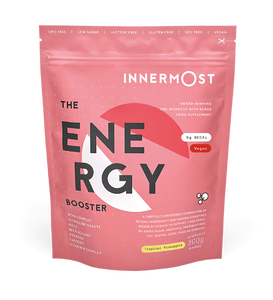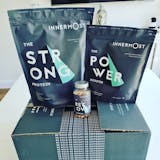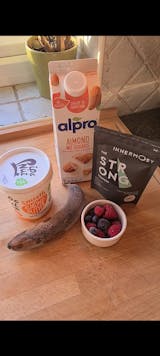The marathon - the magnum opus when it comes to being a runner, (and a feature of so many bucket lists). Something that seems so impossible, yet so many make possible.
Preparing for a marathon is no small feat. It requires physical stamina, mental resilience, and a well-thought-out strategy. Whether you're a first-time runner or a seasoned athlete, marathon training is a journey that demands consistency, science-backed planning, and smart recovery.
With the largest organised marathons on the horizon (think Dubai, Boston and London), we thought there was no better time to reignite the conversation and discuss just how you can smash your marathon goals, with targeted training, nutrition and perseverance.
This guide explores everything you need to know about training for a marathon, how long it typically takes, and the best practices to follow for optimal performance and recovery.
Right, let’s get into it.
Setting your marathon goals
Before lacing up your trainers and mapping out your training schedule, first you need to understand what you want to achieve with the marathon.
For instance:
- Are you aiming to complete a marathon for the first time?
- Perhaps complete in a target time?
- Shave minutes off a personal best?
- Simply finish feeling strong and injury-free?
These choices should be driven by your own body and what you think can be achieved - one of the biggest mistakes you can make in running or fitness in general is to try and meet someone else’s goals.
It can be daunting to decide these goals, especially if you are starting the process as a beginner. One rule of thumb that can be useful is to set yourself a series of SMART goals for increased objective definition.
- Specific: What is it you are looking to achieve? When are you looking to achieve this by? Are you training for a particular event? Have you run 42.2k before? As the name suggests, you should try and make the goal as specific as possible, with all details included. This will help you tailor your training plan.
- Measurable: Have you defined a measurement for your specific goal? Time related goals might see you tailor your training plan to a particular pace. If you’re normally a half marathon runner and want to build up your measurable fitness to a full marathon, then building up your endurance is key.
- Achievable: Is your goal attainable in the timeframe you have given yourself? If not, maybe it’s worth giving yourself more time? Or even switching to a half marathon, 5k or 10k instead.
- Relevant: Are your goals tailored to you? If not, it might be worth a rethink. This also applies to a training plan. Don’t train for a 5k if a marathon distance is the goal.
-
Time-Based: With a full training plan in place, how long will you need to practice and prepare for the marathon? There’s nothing more likely to set you up for failure than cramming 6 months of training into 4 weeks.
Not only can you use these smart goals to inform what it is you want to achieve, but they will also help you to tailor your training plan going forward.

Marathon training plan tips
So, you’ve got your SMART goals set and know what you want. Next up, it’s about training and fuelling your body, muscles and mind ready for the big event.
The four phases of marathon training
At the core of effective marathon prep is a structured plan. Most programs divide training into four key phases:
- Base building
- Intensity training
- Peak building
- Tapering
Shall we start from the top?
Base building
During the initial base building phase, the purpose is to condition the body through steady aerobic runs and gradually increase weekly mileage. This creates the endurance foundation necessary for more intensive work.
Typically, base building consists of low intensity (conversational pace) but high-volume workouts. The time you take on base building greatly depends on where your fitness levels lie and how long you have given yourself to train.
Base building for a marathon has the benefit of:
- Improving your endurance through cellular adaptations, building the body’s ability to use oxygen effectively, delaying fatigue.
- Enhancing muscle efficiency when burning fat for fuel by preserving carbohydrate stores - these adaptions help the body to keep going for longer (super important for a long distance run like a marathon).
- Increasing injury prevention and post run recovery by strengthening and building muscular, tendon and bone resistance.
Intensity running
Once base fitness is established, the next step is to work on ‘intensity’ based runs. This will see you build anaerobic fitness through high intensity but lower volume runs - generally you want to be hitting around 80% to 90% of your maximum heart rate with these runs.
Tempo runs, hill repeats, fartlek training and interval training are all perfect intensity workouts that challenge your cardiovascular efficiency and improve lactate threshold.
For those looking to hit certain times within the marathon or smash a PB, this training method is for you (although anyone will of course benefit).
Intensity training for a marathon has the benefit of:
- Improved lactate tolerance, meaning that the body becomes more efficient at fuelling the cells during high intensity workouts. The benefit? You can run harder for longer before experiencing fatiguing effects - read this study for more detail.
- Increased speed and power when running by building more fast-twitch muscle fibres. This helps to improve running speed - especially useful when going for a PB.
- Building mental toughness. Pushing yourself now in training will teach you how to work through mental and physical discomfort and ingrain the resilience needed for what will likely be the most challenging run of your life.

Peak training
The next part of your training plan will consist of something called ‘peak training’.
Generally starting at around 60% through your training journey, this is where you are going to put your endurance and pace building to the test by completing the longest distance runs so far.
Running distances should get longer until you start going for that 30+ km distance (slowly building up of course). For those who have set PB, or pace-related SMART goals, this is also where you are going to practice at a longer distance.
Rather than full long distance, we would suggest initially breaking up your runs into longer intervals to help build up your long-distance pace. We would recommend 10k intervals as an effective tool for marathon pace training.
The important thing here is to make sure you are carefully planning your runs with effective sleep and effective nutrition (see our nutrition tips below). The last thing anyone wants is to go through months of training only to miss out due to injury.
Peak training for a marathon has the benefit of:
- Building your confidence
- Simulating the distances of race day. Completing this stage will give you a complete sense of the runners high. The hard work is done, and now you know you can do it!
- Increasing endurance and stamina, building on the endurance you may not even realise you have built up from base and intensity training.
- Driving greater fatigue resistance.
- Gradually building to these longer distance workouts improves lactate tolerance, enhances muscle efficiency and builds the body’s ability to use oxygen effectively.

Tapering
Right, you’ve completed the longest distance prep runs and are ready to go.
So why is there still one phase of training left?
Tapering (while often overlooked) is the final stage of marathon training
It's the stage where you know that the hard training is done and race day is almost here. It occurs around the final 2-3 weeks of training and sees much shorter runs taken at your target marathon pace.
The goal here is to reduce the fatigue you’ve built over the many months of training and ensure you are in the best levels of fitness on the big day. It allows the body to recover and rebuild, ensuring you're rested, primed, and sharp come race day.
While it might sound counterproductive, the science here doesn’t lie. According to a 2007 meta-analysis, tapering your runs can improve performance by up to 3%.
Tapering before a marathon has the benefit of:
- Replenishing energy stores.
- Allowing for muscle and tissue repair.
- Improving aerobic capacity.
- Boosting confidence through improved mental clarity.
Nutrition and supplementation for endurance for marathon training
With that said, physically and mentally training your body is only one part of the puzzle. You want to be sure that you are fuelling effectively with complete nutrition.
If this blog hasn’t made it obvious, running (especially these sorts of long distances) stresses the body. This makes nutrition your most powerful tool for recovery and performance. A balanced diet rich in carbohydrates, lean protein, and healthy fats can help fuel training and accelerate recovery.
We’ve written a whole blog around nutrition that we would recommend checking out for further info.

When weekly mileage begins to build and time becomes scarce (as it does, we all have busy lives), supplementation can also offer a smart, efficient solution. Protein, in particular, is critical for muscle repair, with between 1.4 to 1.6g of protein per kilogram of body weight required per day to support recovery during the training process
A high-quality protein supplement can fill nutritional gaps, support muscle synthesis, and help reduce soreness. Innermost The Strong Protein for instance offers 31g of protein per serving, helping to maximise muscle growth throughout the training process.
Beyond protein, other supplements like electrolytes, adaptogens, and functional nutrients can also play a role in effective marathon nutrition - see our The Hydrate Blend premium sachets, The Rise Capsules and The Reset Capsules for more detail.
For wellness-focused runners and those with holistic health goals, incorporating ingredients like ashwagandha or reishi mushroom (featured in The Rise Blend) can help manage stress and improve recovery outcomes.
For a more in-depth look at science-backed sports nutrition, check out our complete guide to running supplements.
Making the most of marathon gear
Watches and apps
Good news, today’s runner has more tools and tech at their disposal than ever before, each of which can help assist you on your marathon journey.
Wearables such as a Garmin or Apple Watch can be fantastic for tracking mileage, heart rate, and recovery metrics.
Apps like Strava and Runna provide coaching frameworks and social accountability. These platforms offer feedback loops that help refine pacing, identify overtraining risk, and maintain motivation.
Running shoes
Footwear, too, is a crucial factor.
Investing in a new quality pair of running shoes that match your gait and terrain (beyond being one of the most fun investments for a runner) can prevent injuries and improve efficiency.
For long-distance training, rotating between two pairs helps extend the life of your shoes and reduce repetitive strain.

Recovery tools
Recovery tools, including foam rollers, massage guns, and compression gear, support circulation and muscle repair.
Many science-focused runners also find value in tracking sleep quality and using devices that measure HRV (heart rate variability), offering deeper insight into readiness levels.
What to do on marathon day?
After months of training, it’s finally coming up to marathon day. In many ways, it can feel overwhelming. You’ve done all the hard work and, now it’s simply a waiting game
Or so it seems...
Below we have included our top tips on how to prepare for marathon day, starting from the day before and leading to post run recovery. Shall we jump into it?
The night before the marathon
The night before race day is all about setting yourself up for success.
You’ve done the training - now it’s time to prepare mentally and physically for the big effort ahead.
Eat well, but don’t overdo it. A familiar meal rich in complex carbohydrates (like pasta, rice, or potatoes) with a moderate amount of protein and low fibre is ideal. Avoid anything new or spicy that could upset your stomach.
Hydrate smart. Drink water steadily throughout the day, but don’t overload at night. Add electrolytes if temperatures will be high or if you’ve been training in the heat.
Organisation is also really important for peace of mind (and to avoid any last-minute panics on the day. Lay out your gear. Double-check that everything is ready: bib number, shoes, socks, GPS watch, any supplements, and clothes.
Last up, try and get to bed early but equally, don’t worry if you can’t sleep. It’s normal to feel nervous. A poor night of sleep before a race won’t ruin your performance, especially if you’ve banked good rest earlier in the week and have done all the training to prepare.
Marathon day
When marathon day finally arrives it’s fairly normal to feel an overwhelming mix of nerves and excitement. In the morning, we would recommend a high carb meal around 2-3 hours in advance to maximise glycogen stores and ensure a good amount of digestion time (avoid anything high in fibre that could drive digestive issues).
Below we have included a few other key hacks and tips to best prepare you on race day:
- Arrive early - no-one wants the added pressure of arriving late. Best remedy? Arrive in good time on race day, even if that means waking up an hour or 2 earlier.
- Stick to what you know - marathon day is not the day to be trying out new things. Don’t go testing new running shoes, gear or supplementation on race day.
- Don’t start too fast - As I’m sure you’ve worked out over the many months of training, starting out too fast is a recipe for disaster. Try not to get carried way by the initial adrenaline at the start line and stick to the pace you have set yourself.
- Use water stations wisely - Water stations are there for a reason, but equally (depending on the marathon) they will be well spread out across the track. Try to tailor water sips from your own bottle around where these stations are placed to maximise your hydration intake.
- Keep mental check-ins - We cannot stress how much of a mental game running can be. Try not to keep checking your watch (if you have one) or fixating on distance/pace - this can lead to increased mental fatigue.
Remember, you have trained for this, and you can do it!

Post-Race Recovery
Congratulations! You’ve done it! You’ve completed a marathon and entered an elite group of sportspeople!
Now’s the final stage and one that could make or break how you feel over the next few days/weeks. Recovery. Your body will have been pushed to its limit, so what you do next matters.
- Keep moving - It will feel oh so tempting to collapse on the ground in exhaustion and celebration - before you do so, try walking for 10-15 minutes after finishing to keep blood flowing and prevent cramping.
- Refuel quickly - Aim for a snack or shake with a 3:1 ratio of carbs to protein within 30 minutes. While most organised marathons will provide a finishers bag with snacks to enjoy, The Recover Capsules are your secret weapon here.
- Hydrate and rest - Rehydrate slowly over the next few hours and take it easy for the rest of the day. Elevate your legs and focus on gentle mobility. Post marathon, you should give a full week of rest before resuming any form of structured training. Low impact activities like walking (those who live in Dubai, why not join one of our Walk Club group sessions?), swimming, or yoga are very beneficial here.
- Reflect and celebrate - This goes without saying, but you’ve completed a marathon! Take time to celebrate your experience and appreciate the accomplishment with friends and family.
Time to get marathon ready
So, there we have it!
Training for a marathon is a transformational experience. It requires structure, self-awareness, and smart choices about how you train, fuel, and recover. We’re hoping that if nothing else, this blog has conveyed that anyone can achieve a marathon distance target - whether starting as a beginner or aiming to get a PB.
For added insight and performance, why not explore our collection of Innermost protein powders, tailored to fit a variety of lifestyles and training needs.
Remember, train smart. Recover well. Run far.
Frequently asked questions
What time should I aim to achieve with a marathon?
While you should always try and tailor your marathon target to your individual goals and body, below are a handful of time brackets depending on whether you are new to running or a seasoned jogger.
- For beginners: Your goal may be to simply finish the race within the cut-off time (typically around 6 to 7 hours). For many new runners, a finish time between 4:30 and 5:30 hours is realistic with consistent training.
- For intermediate runners: Those who have completed a race before may aim for a sub-4-hour finish. This requires maintaining a pace of approximately 5:41/km (9:09/mile).
- For experienced runners: More advanced runners often set aggressive goals, like breaking 3:30 or even 3:00. These targets require disciplined pacing and advanced training strategies.
It’s important to match your goals with your lifestyle, current fitness, and time commitment. Setting realistic, progressive goals ensures long-term motivation and helps avoid burnout or injury.
What’s the right timeframe to begin marathon training?
Another common question for runners is ‘how long will it take to train for a marathon?’
While the exact answer can vary wildly based on both the capacity you yourself have (not to mention the number of weeks/months before race day) and your prior running experience, for those aiming to build a sustainable fitness base, you ideally want to look at a six-month (24-week) plan.
This provides ample time for optimal progression without rushing the 4 training stages mentioned in this article.
Months 1-2: Base Building
- Focus on consistency through base building training
- Aim for 3-4 runs per week at conversational pace
- Gradually increase weekly mileage (start with 15-25km)
- Introduce intensity runs
- Include one cross-training or active recovery day
Months 3-4: Building Strength & Endurance
- Increase mileage to 30-50km per week
- Continue intensity runs
- Introduce peak long runs that build up to 20-26km
- Begin fuelling practice during long runs (supplements, hydration)
Months 5-6: Peak and Taper
- Peak weekly mileage 50-65km
- Longest run: 30-35km, 3-4 weeks before race day
- Tapering starts 2-3 weeks out, reducing mileage by 20-30%
- Maintain intensity, reduce volume
Each phase should prioritise injury prevention through mobility work, strength training, and recovery protocols.
References
- Bosquet, L. et al. (2007). Effect of tapering on performance: a meta-analysis. Medicine & Science in Sports & Exercise, 39 (8), 1358 -1365. Click here.
- Hughes, D., Ellefsen, S., and Baar, K. (2018). Adaptations to Endurance and Strength Training. Cold Spring Harb Perspect Med, 8 (6). Click here.
- Xie, H., Mao, X., and Wang, Z. (2024). Effect of high-intensity interval training and moderate-intensity continuous training on blood lactate clearance after high-intensity test in adult men. Frontiers in Psychology, 39 (8). Click here.
- Jager, R. et al. (2017). International Society of Sports Nutrition Position Stand: protein and exercise. J Int Soc Sports Nutr. Click here.
- Jiménez-Alfageme, R. et al. (2025). Nutritional Intake and Timing of Marathon Runners: Influence of Athlete’s Characteristics and Fueling Practices on Finishing Time. Sports Med Open. Click here.
- Burke, L. Hawley, J. et al. (2011) Carbohydrates for training and competition. Journal of Sports Sciences. 29. Click here.
- DeAngelis, J. (2024) Target Heart Rate Zones: Safely Maximize Your Workouts, Brown Health. Click here.
























